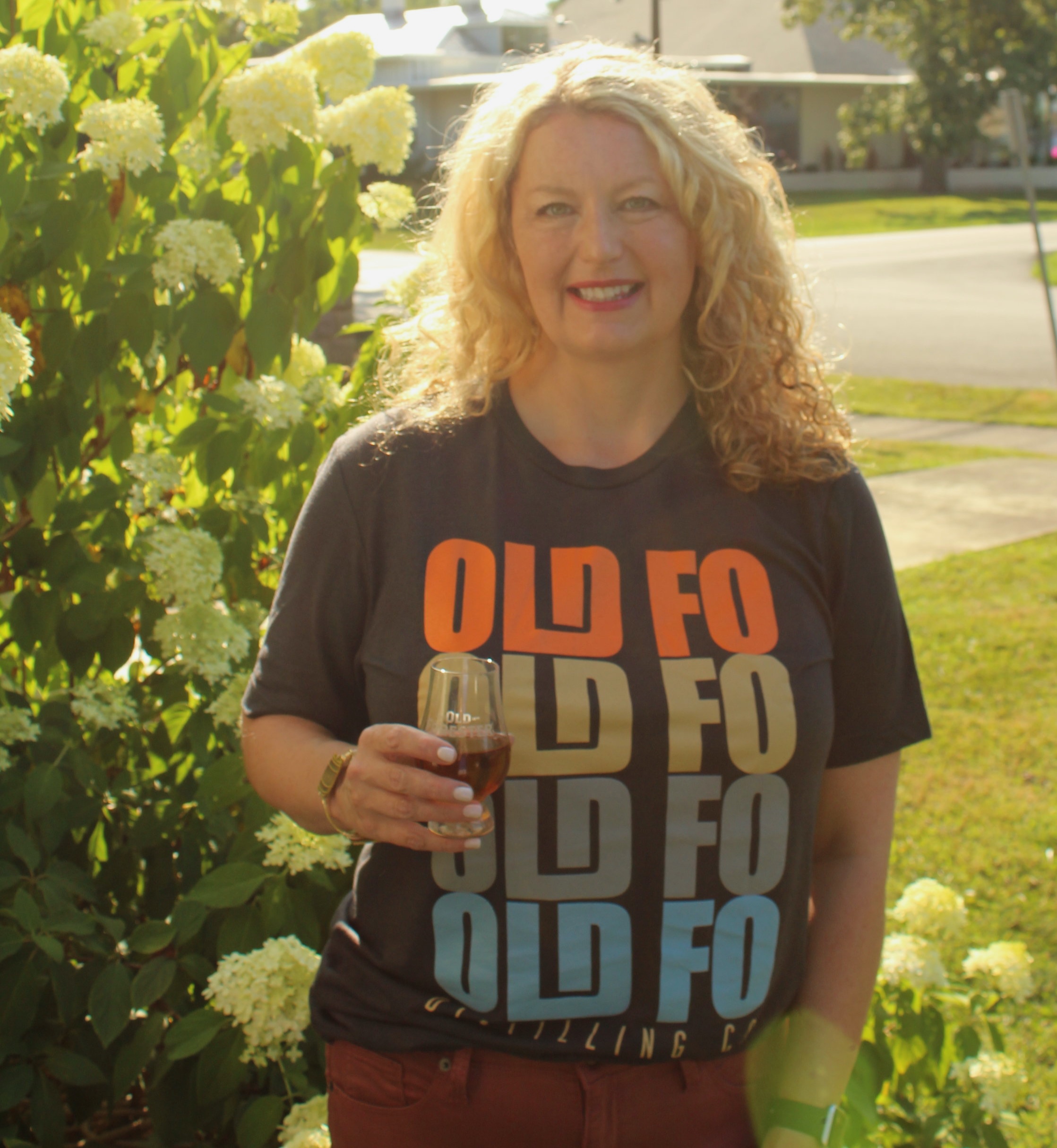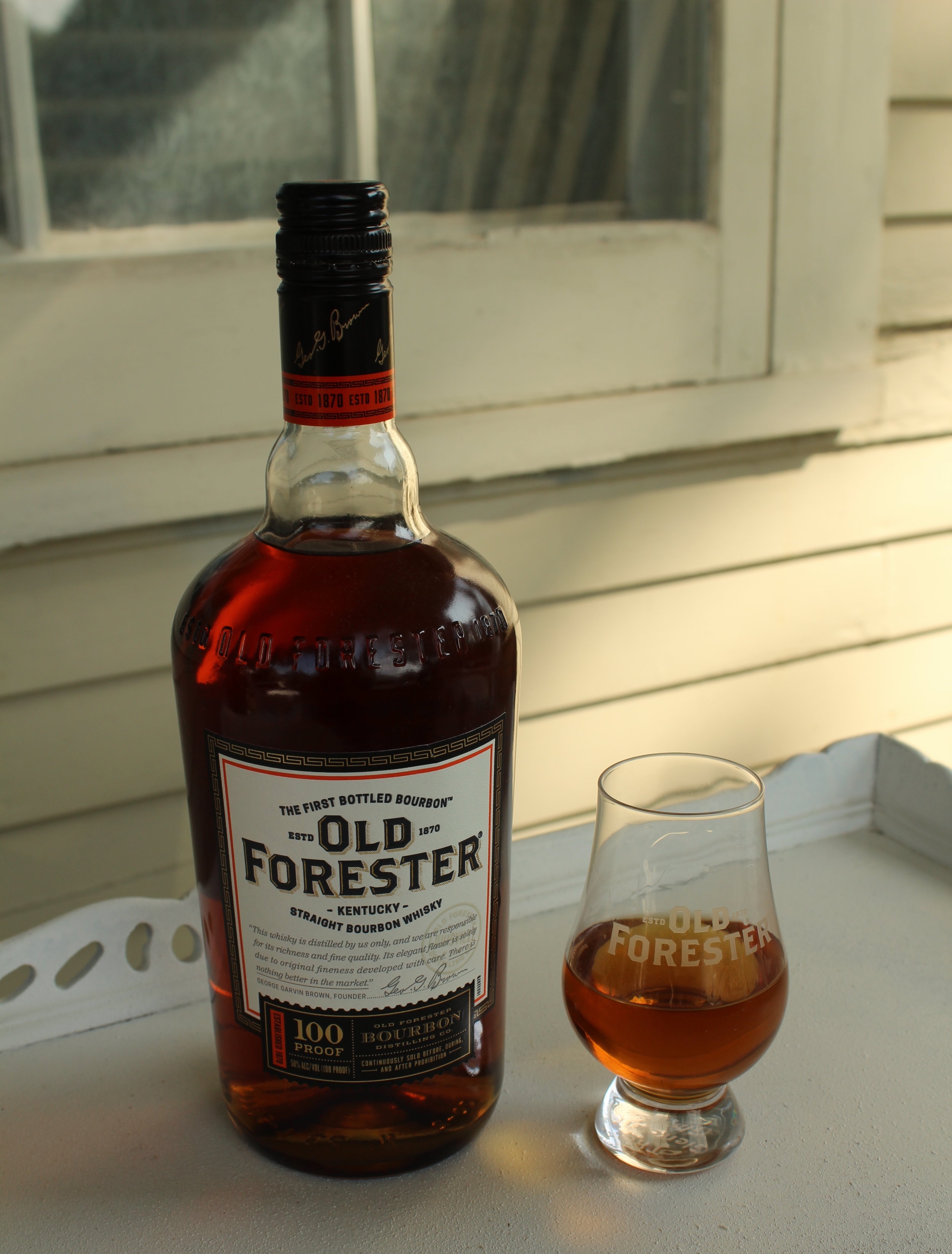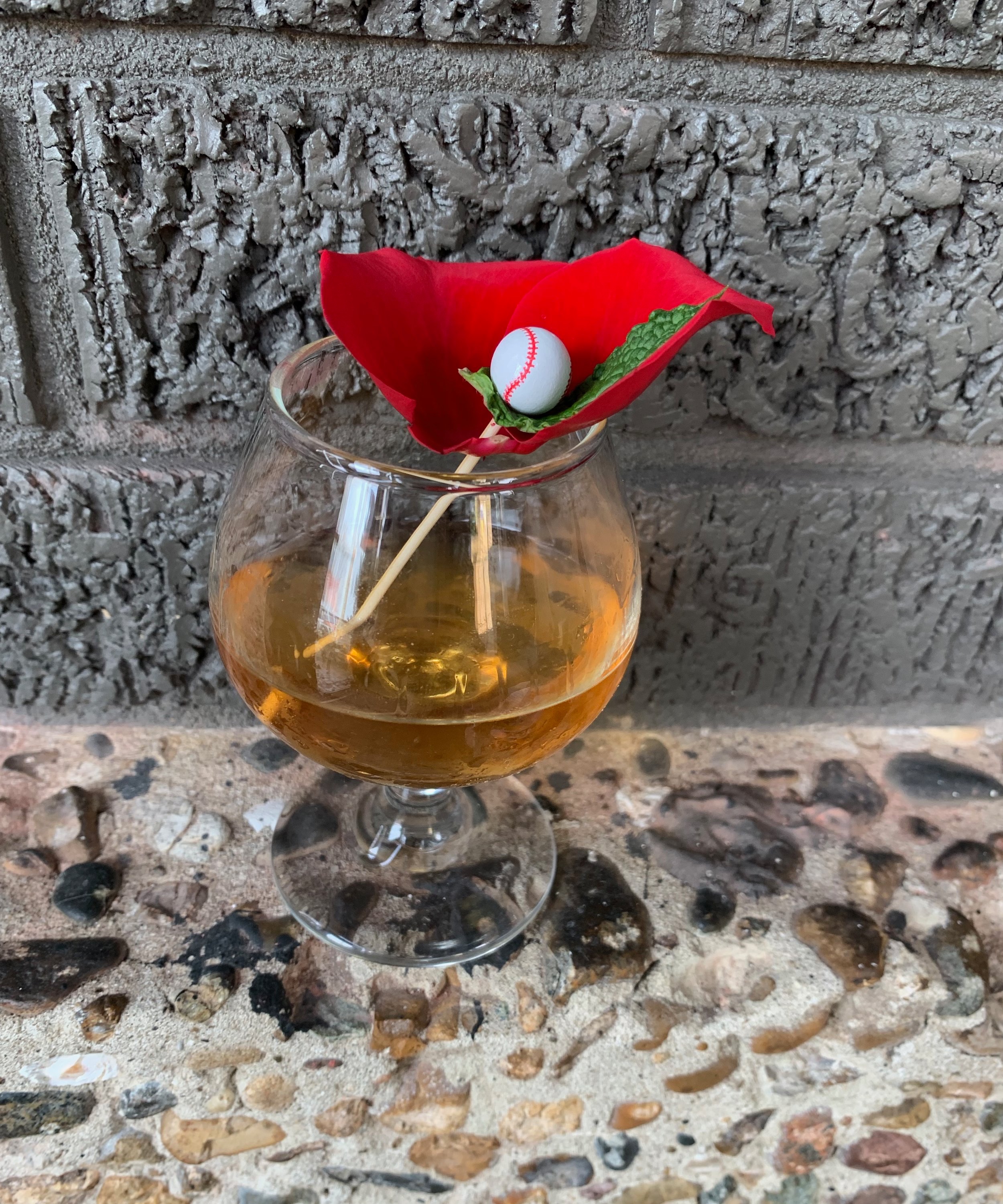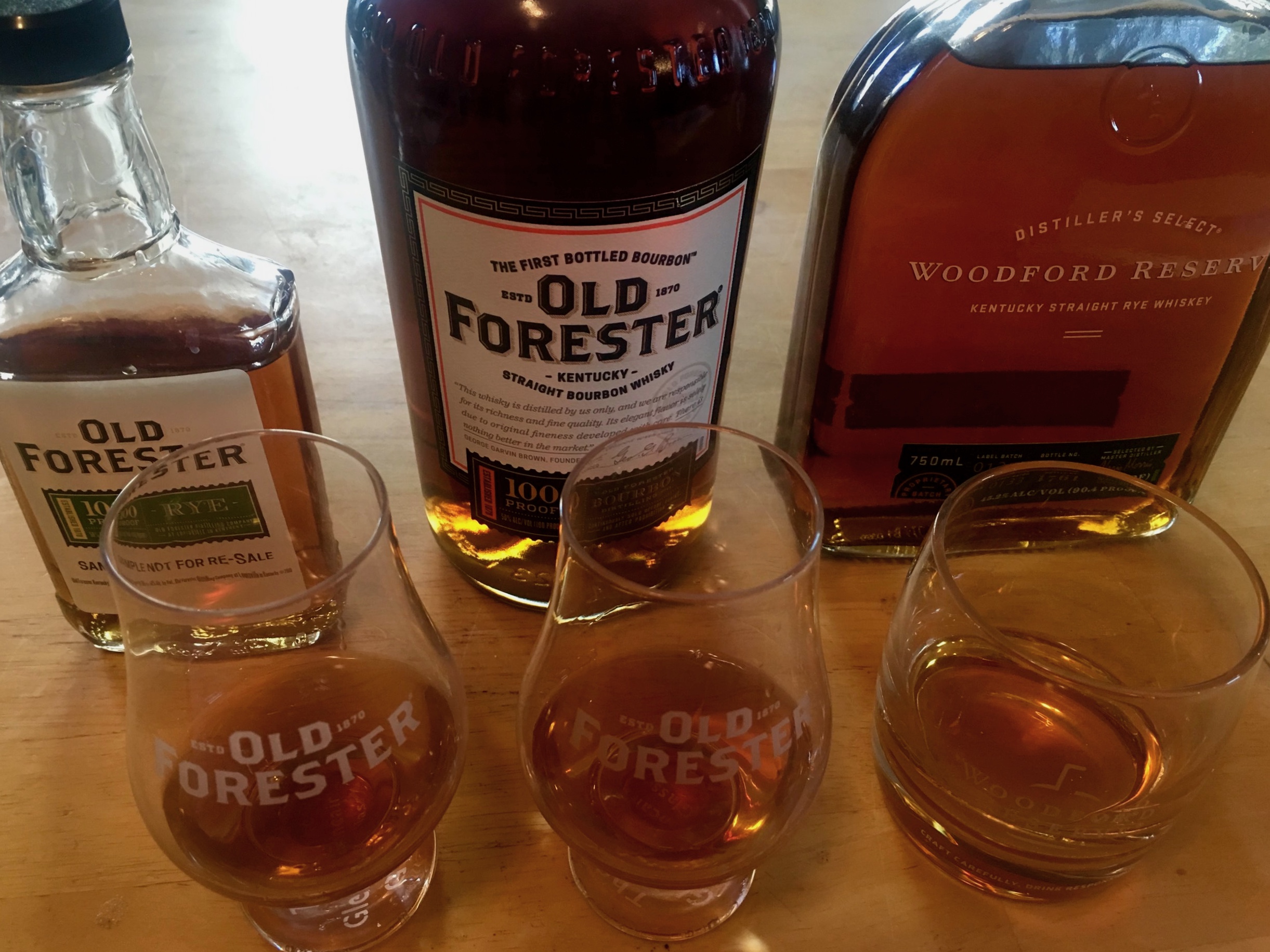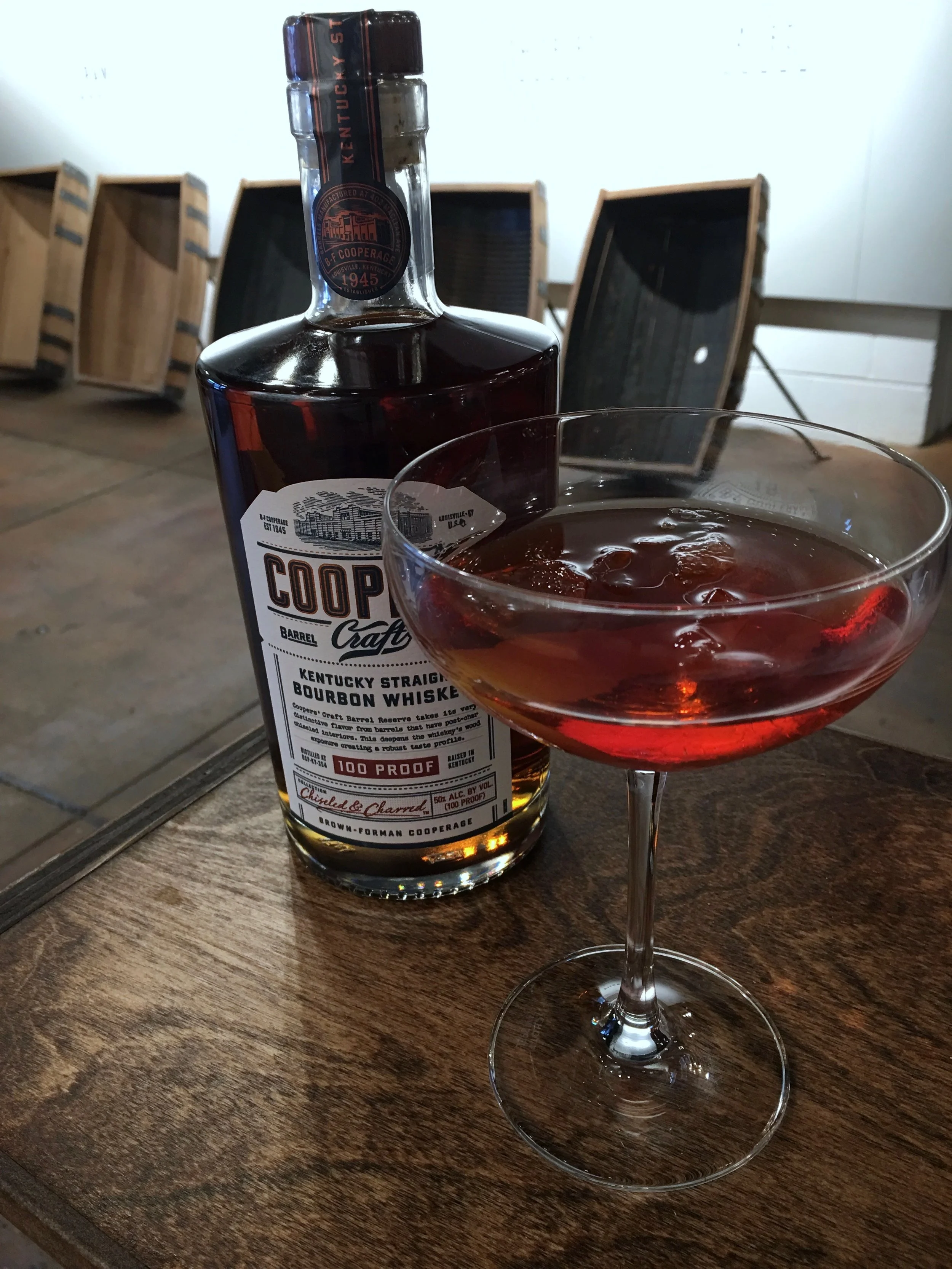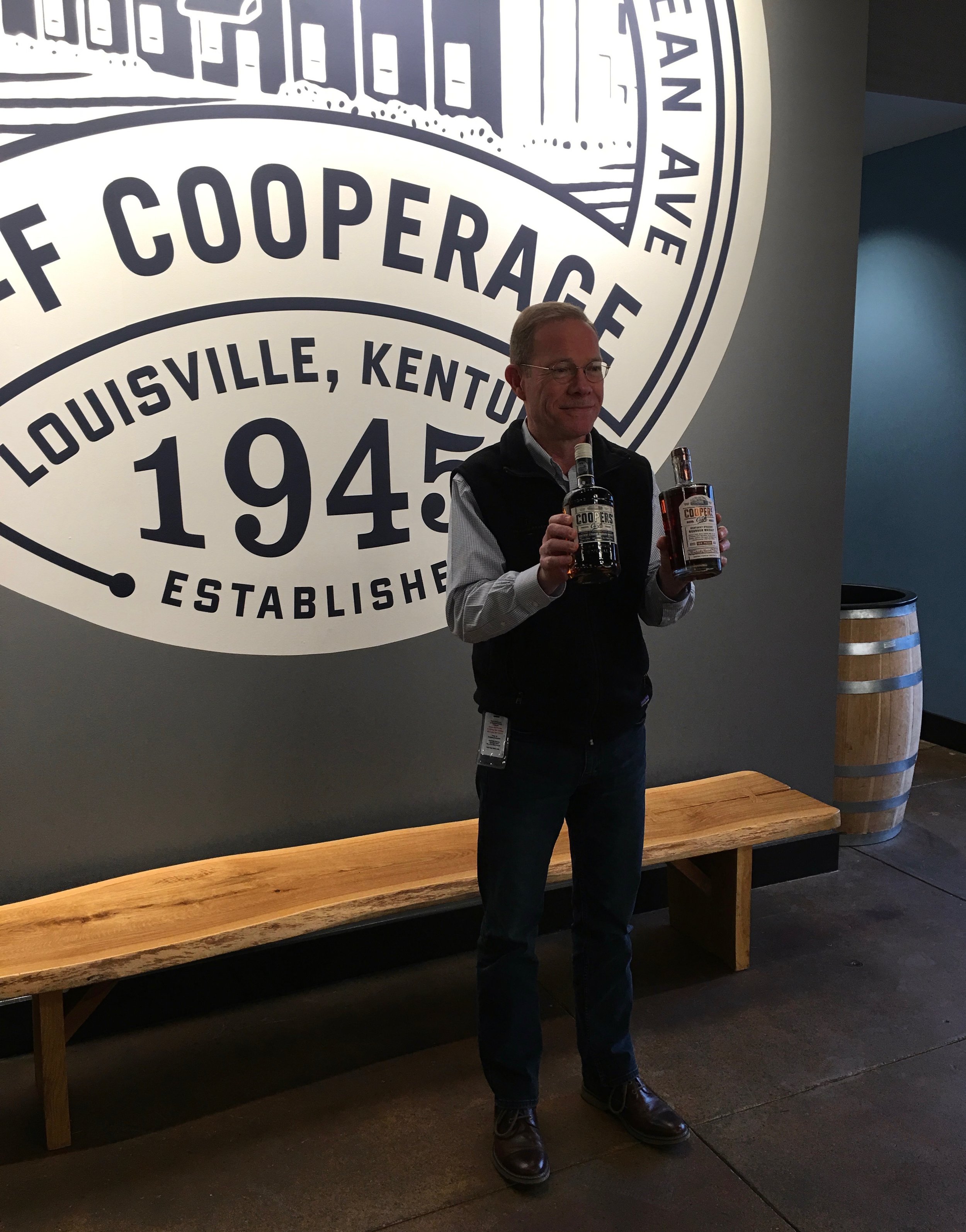Old Forester 100 Proof
My go-to bourbon.
Sometimes, people, especially non-Kentuckians or bourbon newbies, often ask me what my go-to bourbon is. Of course, that’s never an easy question. Everyone in Kentucky knows that a whole lot of factors go into that answer. Is there someone in the room who works at a particular distillery? Then their employer is definitely your favorite. Other factors include where your tastebuds are at the moment, whether you’re sipping or mixing in a cocktail, etc., etc. But, even with all of those disclaimers out of the way, I find that my answer usually is Old Forester 100 Proof.
I straight-up love Forester 100 as a sipper. I’m a huge fan of the warm butterscotch aroma, the apple and spice palate, and the toffee and clove finish. I also love that it’s at an incredible price point, and that it makes a fantastic cocktail. I think that this one belongs on every home bourbon bar.
I’ve had the opportunity to get to know a few of the folks on the brand team at Old Fo, and I can tell y’all that they are incredible. Master Taster Jackie Zykan is the coolest lady ever, and the entire team has an incredible vision for the future of the label. If you love Kentucky history and good whiskey, you should definitely visit the Old Forester Distillery and learn all about the first bottled bourbon! (My t-shirt is available in the distillery gift shop!)
I’ve also had a few people ask about my bourbon barrel bracelets — I always wear these to whiskey-tasting events. These are by Bourbon & Boweties and are available exclusively at Sweet Mash Goods in Lawrenceburg. These are my very favorites, and are a subtle way to reflect my love of bourbon every day!
What’s your go-to bourbon?
How to Curate a Home Bourbon Bar
Tips for summer entertaining from HerKentucky and Stoneware & Co!
Today is National Bourbon Day!
Here in Louisville, it seems like every day is National Bourbon Day. The bourbon industry is booming, with tours and culinary experiences and so many amazing tributes to Kentucky’s favorite spirit. And, of course, there’s nothing like enjoying a bourbon at home with your friends and family. Today, I’ve teamed up with Stoneware & Co. to provide you some great tips for curating your home bourbon bar, featuring Stoneware’s stunning Embossed Running Horse serving pieces! (Check out the end of this post for a Bourbon Day gift to y’all from Stoneware and HerKentucky!)
Step #1: Keep a range of flavors!
Here’s the thing. You don’t need to spend a fortune stocking your bourbon bar. Yes, there are some fabulous high-end, high-priced selctions. But there are also some great entry-level bourbons that your guests would love to enjoy with you. You just need to know a little bit about your bourbon. I suggest that you start with a range of flavors by mixing up the mash bills in your collection. Federal law mandates that, to be called a bourbon, a whiskey’s mash bill, or recipe, must consist of at least 51% corn. The remaining 49% of grains in the mash bill contribute strongly to the flavor of the bourbon. As a general rule, a mash bill that contains wheat will provide a sweeter note, while the addition of rye provides some spice. The biggest trend in whiskey right now is barrel finishing — finishing a bourbon in a second barrel, whether it’s a different oak barrel, a custom-staved barrel, or a barrel that once housed a different spirit. I like to keep a couple of “finished” bourbons on hand to provide a different tasting experience. And, while it’s not an actual bourbon whiskey, I like to keep one or two rye whiskeys on board (produced at Kentucky’s distilleries, of course!) to accommodate those folks who like a truly spicy whiskey. At my house, Bob especially likes ryes for cocktails. Here is a great overview of popular mash bills.
Step #2: Select a range of proofs.
Proof is an indicator of the alcohol content by volume. In the U.S., this is indicated as a number representing double the alcohol percent. So, for example, an 86 proof bourbon is 43% alcohol. Obviously, a lower proof will result in a less intoxicating substance. Some folks prefer to sip on low proofs, while others like a higher. If you’re entertaining a group of true bourbon drinkers, you’ll want to have a couple of proof options to meet different tastes. Here’s a fun fact: In blind taste tests, it’s often found that female bourbon drinkers will prefer a higher proof.
Tip # 3: Don’t forget the finishing touches!
While many bourbon purists drink the product straight, your home bar should also include bitters and vermouth for popular cocktails like the Manhattan. You’ll also want to stock up on sugar cubes, oranges, maraschino cherries, and mint for garnishes. I’ve recently seen a lot of creative cocktails that utilize more savory herbs like basil and rosemary — the sky’s the limit! (Check out my sorority sister Heather Wibbels’ award-winning basil julep recipe here!!) I also love to have plenty of simple syrup on hand. I usually make a double batch of simple syrup — using a 1:1 ratio of sugar to water — and separate it into halves. One stays as simple syrup for drinks like an Old-Fashioned, while the other is mixed with lemon juice to make a sour mix. I love Stoneware’s 1 quart Bar Pitcher for serving syrup —it’s so easy to pour your desired amount into each cocktail!
Tip #4: Serve water and Ice in style!
Here in Louisville, we’re fortunate to have the very best tap water — it’s actually won awards! In fact, Kentucky’s water supply is pretty special. The rich limestone throughout central Kentucky provides the clear-tasting water that first made our bourbon special, and that nourishes our famous racehorses. Of course, no bourbon bar is complete without ice and a pitcher of water. Everyone has their own preferences when it comes to drinking bourbon — some folks like to dilute their spirits with just a drop or two of water, and some folks prefer a few — or a lot — of ice. I love Stoneware’s Embossed Running Horse Bar Pitcher and Ice Bucket to serve up water and ice in style. The best part is that these pieces, along with the julep cups, can be stored in the freezer so they’re appropriately chilled for maximum serving efficiency!
Tip #5: Keep some snacks on hand!
Don’t forget to have some snacks on hand to both compliment the flavors of the bourbon and to keep your guests from drinking on an empty stomach! Play with flavors you like to pair with bourbon , from salty cheeses to dark chocolate! It’s amazing how well so many different tastes coax out amazing notes in your whiskey!
Stoneware has graciously provided a coupon code, valid through June 20th at midnight, to help y’all stock up your own collection of handmade Kentucky pottery. Use code BOURBONBAR at online checkout, in store, or on phone orders to take 10% off your purchase!
Cheers, y’all! Let me know how your favorite tips for entertaining with bourbon!
(Stoneware & Co provided me with products for use in this post; as always, all opinions are my own. In fact, I collected Stoneware far before I had the opportunity to collaborate with them!)
BenRiach Scotch Whisky Luncheon at Ostra
Pairing Single Malt Scotch with inventive food!
The cleverly named “Peet Rose” cocktail was created by Ostra for this event.
I recently attended a lunch tasting of BenRiach Scotch Whisky at Ostra. This was an invitation I was thrilled to receive; I don’t know a ton about Scotch, and the easiest way to learn more about a spirit is to attend a tasting led by an expert. BenRiach is a 120 year-old distillery of single malt scotch; its acquisition by Louisville-Based Brown-Forman in 2016 certainly makes it more accessible to Kentucky’s whiskey lovers. Stewart Buchanan, BenRiach’s Global Brand ambassador, led us through the tasting of four BenRiach expressions, each of which was paired with a creative and delicious food course.
Stewart Buchanan, Global Brand Ambassador for BenRiach.
In walking us through the tasting, Stewart pointed out that many folks who are new to Scotch often associate the spirit with heavy notes of smoke and earth. The peat flavor is is introduced into the spirit by drying the core grain — malted barley — over peat smoke for several hours. BenRiach offers both peated and unpeated expressions, offering a lot of room for exploration of the spirit’s flavor.
Tasting notes for BenRiach Whiskys
BenRiach 10 Year:
This accompanied our starter dishes of a kale pallet, oysters, and spotted prawn ceviche. I loved the mix of a lighter whiskey with these fresh and citrusy dishes.
Proof: 86
Nose: toffee, vanilla and pear
Palate: green apple, sherry, clementine
Finish: light spice, nutmeg
Ostra’s Jay Kale salad with citrus vinaigrette and goat cheese.
BenRiach 20 year
This accompanied a main corse of Wild Boar Gemelli, truffle honey fries, and crispy brussels sprouts. Honestly, the whisky and the pasta were so amazing together that I completely overlooked my blogger duties. I loved the interplay of the gamey boar with the sweet, lightly smoky whisky. I really liked this expression a lot; the notes were more familiar for someone versed with American whiskeys.
Nose: Baked Pear
Palate: honey and red wine
Finish: lemon and barley
We finished with two peated expressions, Benriach Curiositas 10 Year and BenRiach Authenticas 25 year. These were served with two amazing desserts: the cricket flour brownies and the red velvet churros with cayenne nutella dipping sauce. While I’ve never been one for peated whiskys, this pairing really worked well to coax out the notes of the spirit. I don’t fully trust my palate enough to give tasting notes on the peated whiskys; I simply haven't worked with them enough to get a great read on what I’m tasting and smelling. The Authenticas 25 year opened up to a lovely raisin palate, which worked well to cut the indulgent chocolate notes of the dessert. (And that churro was nothing short of lfie-altering!!)
Thanks so much to Brown-Forman, BenRiach, Lemonade PR, and Ostra for the invitation. I look forward to further pursuing my nose for Scotch!
How to Taste Bourbon Like a Pro
Step-by-step guide to tasting Kentucky bourbon
Kentucky bourbon is bigger than ever. Of course, 95% of the world’s bourbon is made here in the Commonwealth, as is 100% of the bourbon that’s worth talking about. It’s an $8.6 billion dollar industry that generates over 20,000 jobs for Kentuckians. Bourbon impacts every Kentuckian. But, no matter how hot the industry is, I’ve noticed that there are plenty of Kentuckians who are still a little scared to drink bourbon. It’s a question I get fairly often from blog readers and social media followers: How do I get started with tasting bourbon?
As a bourbon writer, I’ve had the incredible opportunity to attend tastings led by some of the most interesting names in bourbon. I’ve watched the legendary Fred Noe of Jim Beam demonstrate his “Kentucky Chew” technique, participated in an intensive sensory tasting session led by Elizabeth McCall and Chris Morris of Woodford Reserve, the masters of (click here for information on how you can attend Woodford Reserve Tasting Academy, which I promise you’ll want to attend!), and been among the very first media members to sample the most recent Angel’s Envy offerings. I’ve picked up a few tasting tips along the way, and I want to share them with y’all.
Setup:
Now, it’s great if you have the opportunity to go to a tasting led by a professional. If you’re in Louisville, there are great classes at Westport Whiskey and Wine. Lexington and Louisville both have fantastic classes at Total Wine and More. And, of course, there are tasting opportunities on all of the distillery tours. But, it’s also pretty cool to setup a tasting at home, so you can learn about your own palate as well as your friends’ and family’s.
Step 1: Select your Whiskey.
If you’re going to have a whiskey tasting, you’ll want to select a whiskey. Now, many Kentucky distilleries produce a bourbon and a rye. These are both types of whiskey, and can be produced using the same equipment. Absolutely NOTHING marks you as an amateur quicker than calling a rye whiskey a “bourbon.” If you take one thing away from this blog post, please remember that. The main difference is the grain content. Bourbon whiskey must have a recipe, known as a mash bill, of 51% corn or higher, while the mash bill of rye is at least 51% rye. I find that, when selecting whiskeys to taste, it’s good to pick a theme. I often go by distiller. When sampling the new Old Forester Rye, I tried it against the Old Forester Signature Bourbon, as well as the Woodford Reserve Rye, as these were all produced under the supervision of the same Master Distiller, Chris Morris, under the two major Brown-Forman labels. Another easy starting point would be to try Maker’s Mark with Maker’s 46 or Woodford Reserve with Woodford Reserve Double Oaked. These comparisons will show you how the very same bourbon develops a different taste when finished in different barrels. You can also choose a flight consisting of one from different categories — wheated, high-rye bourbon, rye, etc. — to really see the differentiations. There is a great guide to hosting a tasting on the Kentucky Distillers Association website, and all of the major brands have really good information on their websites to help you learn about what you’ll be tasting before you buy.
Step 2: Set it up.
There really is no tasting glass like the glencairn for tasting. The tulip-shaped glass helps you experience the aroma of the bourbon as it’s supposed to be. If you don’t want to invest in tasting glasses just yet, you can use rocks glasses. Set up each tasting station in the same order, pouring about an ounce of whiskey into each glass. We’re not here to take shots or get drunk. The idea is to have enough juice in each glass to get an idea of how it tastes. Set your samples out in ascending proof order, so that a higher proof won’t overwhelm the flavors of a lower-alcohol spirit.
Step 3: Accoutrements
Turns out, you actually do need a few more things on hand for a bourbon tasting than just bourbon and glasses. Who knew, right?!?! You’ll need some good quality, flavor-neutral water. Here in Louisville, the best thing is actually our award-winning tap water, but to paraphrase Ina Garten, bottled water is fine. The water serves both as a palate cleanser and, if needed, for a drop or two to dilute the spirits. Sometimes, after the initial taste of the whiskey, it’s nice to add a little water (no more than a drop or two) to cut the proof and really dig into the flavor.
You’ll also want some crackers, bread, or popcorn to serve as a palate cleanser while tasting. And, although we’re limiting the amount of alcohol that’s being consumed in the tasting, you’ll want to have some appetizers or snacks on hand to offset the intoxicating effect. It’s also interesting to try some different food samples with your whiskey tasting to coax different flavors out of the drink. The Woodford Reserve flavor wheel tasting calls for aged parmesan, toasted hazelnut, dried cranberry, an orange slice, dark chocolate, and sorghum. I often make some substitutions when playing around with food pairings: I like Kerrygold Dubliner cheese rather than parmesan, and often use fresh or dried cherries and toasted pecans — these are just my taste preferences, and serve a similar purpose in drawing different notes out of any whiskey, not just the Woodford expressions.
Tasting
So here’s the thing. You honestly already have the only tools you need for a bourbon tasting: your own taste buds and curiosity. The most important thing here is taking the time to really be in touch with the sensory experience. Don’t let yourself fall into the trap of liking what you’ve heard is good, what “the experts” like, or what the people around you say is good. You know what you enjoy. You know if you like Brussels sprouts or red meat or chocolate cake, right? Well, bourbon is no different. Different people have different palates and enjoy different spirits. At the heart of it, that’s how the bourbon industry came to be.
Step 1: Color
The first thing you’ll notice when approaching your bourbon samples for tasting will be the color. The color actually does play a huge role in the tasting experience. The shade of amber of a particular whiskey will often be determined by its proof, age, and degree of barrel char. The above photo is a great illustration of how color predicts the character of a bourbon. Two Coopers’ Craft expressions were made from the exact same mash bill. The original Coopers’ Craft is an 82.2 proof, aged in charred barrels, while the Coopers’ Craft Barrel Reserve is 100 proof and has been aged in a specially chiseled barrel. Both of these factors impact the color of the bourbon, and give you the first clues about how it will taste. Predictably, the sample on the right, the 100 proof, has a far bigger and more complex flavor.
Step 2: Aroma
Your sense of smell has a huge impact on any food or drink that you taste. To get a full sense of a bourbon’s flavor, you should take the time to give it a good sniff before you taste it. Now, to the beginner, the first notes you’ll smell in any bourbon whiskey will probably be vanilla and caramel. These are characteristics of all bourbon whiskeys; they are the result of aging the spirit in charred oak barrels. Sometimes these notes linger beyond your first whiff, and they’re still pretty wonderful. As you smell the spirit, you’ll probably pick up on some other notes, too. These are the result of the specific yeast strains, grain varietals, barrel chars, maturation techniques, and everything else that goes into making a specific whiskey. Pay attention to what you smell. There are no wrong answers. I find that most of the Brown-Forman brands have a really strong pear note. Maker’s Mark expressions smell like creme brûlée. Explore the aroma for yourself and note how smells you enjoy play into flavors you like. If a whiskey has a strong raisin note and you hate raisins, then you’re probably not going to enjoy that spirit. Also, it’s very interesting to see how different conditions — a hot or cold day, how you’re feeling, etc. — play into the aroma you experience for a whiskey. It’s very common to smell something different in the same whiskey on a different day, even for folks who have a highly trained and developed palate.
Step 3: Taste
We’ve spent a lot of time getting to this point, haven’t we. Especially since the goal was supposed to be tasting a whiskey. Well, here we are.
Take a sip. See how it tastes on different parts of your tongue. Really think about the flavors you’re pulling out of the whiskey. Pay attention to your initial, emotional responses. Maker’s Mark always tastes like Christmas to me, both because of its elegant caramel and vanilla notes, but also because of the sensory memory of my great-aunt’s bourbon balls, which she always made with Maker’s Mark. You may sense a nutty flavor or a fruity note; subsequent sips or dilution with water will probably help you figure out what kind of nut or fruit. . If you’re tasting with other folks, you may hear them talk about notes that you absolutely do not taste; this is absolutely normal. There are usually some big notes that everyone experiences, and then other flavors that are way more about the bourbon’s impact on the individual. Some of the most experienced Master Distillers and Master Tasters and bourbon pros I’ve ever met will tell you the same thing: There is no right or wrong way to taste, and everyone picks up on a little something different. Trust your palate and your experience more than reviews, price point, or prestige. I promise this will make you a happier bourbon drinker.
Step 4: Finish
Think about the flavor the whiskey leaves in your mouth after you swallow (or spit) it. Maybe there’s a cinnamon note, or citrus fruit. It’s the final impression of the whiskey, and it often is a little more complex than the first taste.
Step 5: Record it
So, this is totally optional, but I find that the best way to develop my taste in bourbon is to keep a tasting notebook. I use this one, which is popular among the bullet journal crowd. I find that keeping my notes organized helps me to really compare flavors and experiences. I can look back on what I tasted in a specific whiskey and see if I taste the same notes again. It’s a great way to help me recall what I’ve tasted and what flavors I’ve tasted. If you’re interested in taking up bourbon tasting as a semi-serious hobby, I recommend journaling it.
Cheers, y’all! Let me know in the comments if you’ve ever done a bourbon tasting at home or at a distillery!!
Angel's Envy Oloroso Sherry Cask Finish Bourbon Review
Tasting notes on a very limited edition bourbon expression.
Last week, I attended a media preview and tasting of the latest release from Angel’s Envy: Oloroso Sherry Cask Finish Bourbon. Angel’s Envy is one of those small, family-owned whiskey labels that has a cult following — fans love the unique bourbon and rye whiskeys finished respectively in port wine or rum barrels to provide a gently altered flavor profile. The limited release Oloroso Sherry Cask Finish was a pretty big deal to bourbon geeks: it was the first new Angel’s Envy expression produced since 2013, and the first to be produced without the guidance of famed patriarch and Master Distiller Lincoln Henderson.
A mural at the entry of Angel’s Envy pays tribute to legendary distiller Lincoln Henderson
Lincoln Henderson was the Master Distiller for Brown-Forman for 40 years; he created the Woodford Reserve and Gentleman Jack expressions while at B-F. Lincoln retired in 2004, but by 2006 his son Wes persuaded him to come out of retirement work on a new, family-owned distillery project. The result was Angel’s Envy, a name paying humorous homage to the fabled “angels’ share”, the portion of the whiskey that evaporates in the warehouse each year. Mr. Henderson passed away in 2013 at the age of 75; Wes Henderson and his sons Kyle and Andrew continue to run the family business with an eye toward their patriarch’s vision.
Henderson Family Tree
Wes and Kyle Henderson sample new make.
After a quick tour of the distillery, Wes and sons Andrew and Kyle treated our media group to the first “outsiders’” taste of the new, limited edition bourbon expression, Angel’s Envy Oloroso Sherry Cask Finish.
Tasting Notes:
Proof: 100
Nose: Raisin and New Oak
Taste: Sherry, Raisin, and Hazelnut with a secondary toffee note.
Finish: Oak and Floral
This is a really unique expression. I LOVED the nose on this. It was this gorgeous raisin and oak scent that felt like a storybook holiday. The sherry definitely came through on the initial taste; we were told that Oloroso is a drier sherry, specifically chosen to keep the whiskey balanced and not overly sweet. I could see this making a really sophisticated and subtle Manhattan.
This is a very limited run of 3,600 bottles at $199 each. The whiskey will be available at the Angel’s Envy Distillery Store in downtown Louisville and distributed to a handful of Louisville area liquor stores. Public sales will begin on February 15th at 8 am; you can add your name to the VIP Access list by joining the Angel’s Envy 500 Main Club.
After the tasting and lunch, we were treated to a cocktail class with Finishing Room Bar manager Mike Bohn. Mike was so knowledgeable about the history of cocktails and the best ways to coax flavors out of the whiskey. You can sign up here for your own cocktail class.
Thanks so much to Angel’s Envy for the opportunity to sample this new expression!
Old Forester Rye Whisky Review
An interesting and complex addition to the Old Forester whiskey portfolio.
{I was provided a press sample of Old Forester Rye in advance of release. All opinions are my own.}
I don’t know when I’ve so pumped about a whiskey release, y’all. When I heard about Old Forester’s new 100 proof Rye release, I was so, so excited. Old Forester Signature (100 Proof) is one of my all-time favorite bourbons, and I love what Master Distiller Chris Morris and Master Taster Jackie Zykan are doing to create new riffs on Brown-Forman’s flagship line.
I set up a tasting flight to sample the Rye, both for comparison and to take an opportunity to revisit two of my favorite Brown-Forman pours. Along with the Rye sample, I tasted Old Forester 100 and Woodford Reserve Rye. Both Rye expressions have a lower percentage of rye in their mash bill — 53% for the Woodford and 65% for the Forester — while many other brands use up to 90% rye in their rye whiskey. The Woodford Rye is one we reach for frequently at my house; Bob especially likes it to balance out the sweetness in Old-Fashioneds or Whiskey Sours.
Tasting Notes:
I started with the Old Forester Signature as a baseline. As I said earlier, I love this one as a sipper.
Proof: 100
Nose: initial notes of brown sugar and caramel, opening up to butterscotch and oak.
Taste: apple & baking spice
Finish: apple & clove
Y’all, I love this bourbon. It’s versatile in cocktails and wonderful as a sipper. It’s at a fabulous price point, and it plays such an important role in Louisville’s bourbon legacy. Everyone should have this on their bar.
I moved on to Woodford Reserve Rye to switch over from a bourbon mashbill to a rye. I know that opinions on this one are fairly divisive, but I’m a fan.
Proof: 90.4
Nose: initial notes of rye and black pepper; as it opens, there’s a fruity depth and a buttery warmth.
Taste: spice, rye, & sorghum
Finish: apple
Moving from the robust 100 proof of Forester bourbon to the Woodford Rye was certainly noticeable. The lower proof does allow the buttery depth of the whiskey to open up a little more. I love the way this whiskey inverts both bourbon and rye mash bills as a spicy riff on Woodford Reserve’s bourbon expression.
These two favorites set up some pretty stiff expectations for the Old Forester Rye. I was pretty happy to see that this big whiskey lived up to my big expectations.
Proof: 100
Nose: starts out spicy, reminiscent of those cinnamon red-hot candies, before opening up to a buttery depth and notes of banana bread
Taste: rye grain, pear
Finish: peppery with a hint of lemon
I tasted this new against two of my go-to whiskies, and it did not disappoint. It certainly brings that fruit note that is prevalent across the entire Brown-Forman portfolio. The higher proof and spicier rye note differentiates this from both its bourbon sibling and its Woodford cousin. At $23 for a 750 ml, you should definitely have this on hand for both sipping and mixing. I think it would make a really nuanced Manhattan.
Old Forester Rye certainly lived up to my expectations. It manages to be at once unique and familiar, complimenting the 150 year-old Old Forester line in a smart and thoughtful manner.
(Editorial note: I use the American “whiskey” with an e in everyday usage. Brown-Forman rocks the boat by labeling Old Forester products with the Scottish “whisky” moniker, while their Woodford Reserve line is “whiskey”.)
Brown-Forman Cooperage Tour and Coopers' Craft Tasting
Last Friday, I got THE BEST birthday present… from Brown-Forman!
I had the opportunity to visit Brown-Forman’s Cooperage, which I’ve wanted to see for so long! I was among a group of bourbon writers invited to tour the cooperage and sample the newest Brown-Forman bourbon expression, Coopers’ Craft Barrel Reserve. Brown-Forman is the only Kentucky bourbon company that crafts barrels in-house, and the Coopers’ Craft brand of bourbon pays homage to Brown-Forman’s coopers.
Barrel Head Pressing at Brown-Forman
The tour was amazing and so, so cool! We learned that the cooperage produces 300 barrels a day, at the rate of about 1 barrel per 45 seconds! Each barrel is made of approximately 29-33 oak staves, which are pieced together without any glue or nails — it’s simply the cooper’s skill with staves and hoops!
Barrel Assembly at Brown-Forman Cooperage
Every bourbon lover knows that a brief char on the inside surface of the barrel is responsible for so much of the color and flavor of the final distillate. What you might not know is that the smell of charred barrels is pretty heavenly!
Y’all, it was such a wonderful experience. We heard about some of the most loyal employees — a three-generation family of coopers (including a female cooper!) and a cooper who’s on the three-month countdown to his fifty year anniversary. It’s clear that safety, sustainability, and community are the utmost goals of the cooperage!
The cooperage is located next to the new Coopers’ Craft homestead experience. We were among the first to sample the second expression of the Coopers’ Craft line, Barrel Reserve.
While the original Coopers’ Craft bourbon is low proof (82.2), the barrel reserve is 100 proof. Barrel Reserve utilizes a unique, chiseled barrel which allows the bourbon to penetrate into the barrel more deeply . The result is a stronger, spicier expression than the original Coopers’ Craft.
Tasting notes for Coopers’ Craft Bourbon
You can find my Bourbon + Boweties bangle at Lawrenceburg’s Sweet Mash Goods.
After we tasted the original and barrel reserve expressions, we were treated to a boulevardier cocktail.
Best of all, we were joined in the tasting by Brown-Forman Master Distiller Chris Morris. It’s always a treat to talk with Mr. Morris. He’s so brilliant and funny and he knows literally everything about bourbon!
You can visit the Brown-Forman Cooperage and Coopers’ Craft Homestead exclusively through Mint Julep Experience tours.

